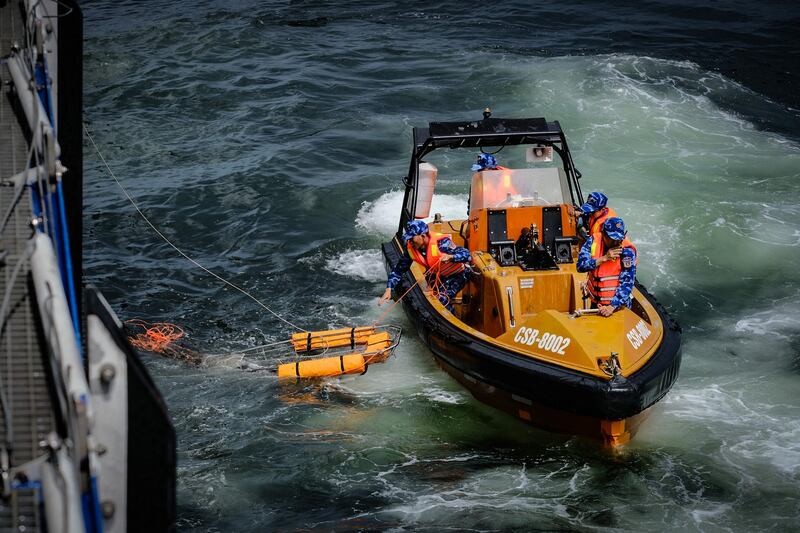The Philippine and Vietnamese coast guards sailed together for the first time in disputed South China Sea waters Friday in an exercise aimed at bolstering cooperation in a sea region where both nations have claims to the waterway.
The drills came seven months after President Ferdinand Marcos Jr. visited Hanoi in January when both countries agreed to enhance collaboration between their coast guard forces and set up a communication hotline to handle maritime incidents.
The sail took place in the West Philippine Sea – waters in the South China Sea within Manila’s exclusive economic zone (EEZ).
“In this exercise, we would be able to promote better cooperation and collaboration among the claimants of the South China Sea. Being members of the Association of Southeast Asian Nations [ASEAN], it would be good for us to have one direction which is the rules-based approach when it comes to the issue,” Lawrence Roque, commanding officer of BRP Gabriela Silang, told reporters onboard.
The drill came at the end of a five-day visit by a 90-meter Vietnamese patrol ship in Manila, which joined the Gabriela Silang, simulated rescues of fishermen in distress along with fire and explosion prevention training.
During the activity, larger ships hosed down a smaller one presumably in distress, while a rubber boat maneuvered nearby.
The scenario was reminiscent of recent developments involving Philippine forces, which have been bombarded by water cannons from Chinese ships during rotation and resupply missions to Manila's outpost in the South China Sea.
Regional tensions
Defense analysts said Friday’s drills were meant to demonstrate resolve and cooperation despite regional tensions.
Vietnam, a fellow Southeast Asian country, has been engaged in artificial island-building in areas it claims in the region, though it maintains friendly relations with the Philippines.
Even as the Philippines has experienced maritime wranglings with China, neighbors have been quietly observing on the side despite their own conflicts with the regional super power, analysts said.

“One of the issues in the region has been the lack of open support from coastal states and ASEAN as a grouping, to the Philippines in the face of China’s aggression in their EEZ,” Jennifer Parker, a defense analyst from the Australian National University’s National Security College, told BenarNews on Friday.
She was referring to ASEAN, a 10-nation bloc that includes sea claimants Brunei, Malaysia, the Philippines and Vietnam.
“Joint sails are a positive way of demonstrating support – it sends a message that the Philippines isn’t alone,” said Parker, who has two decades of experience at the Australian Department of Defense.
Parker noted that the Philippines-Vietnam exercise was the latest cooperative activity in the sea region involving Manila.
Earlier this week, the Philippines, United States, Australia and Canada took part in a " multilateral sail" in the South China Sea.
“I don’t think in the near-medium term, China will change their position on the nine-dash line; it is too ingrained in their current national identity. However, I do think China can be swayed to reduce the level of aggression by which they try and enforce their claims,” Parker said.
The support of regional players such as Australia, and far-flung allies including Canada, on top of the backing by the Philippines’ staunchest military ally, the United States, in the face of China’s aggression was also crucial, she said.
“Support from Canada and extra-regional actors demonstrates [the maritime dispute] is a global concern, not just a regional one,” she said. “This is important to counter China’s narrative that it’s a regional issue only, which allows China to use its relative military and economic power to the region to coerce coastal states.”
International security analyst Rommel Banlaoi said the best way for states was to “engage” China for a peaceful solution to the dispute.
While the joint exercise between Vietnam and the Philippines was an “exemplary practice,” there is room to expand it and include Beijing, said Banlaoi, chairman of the Philippine Institute for Peace, Violence and Terrorism Research.
“The war games will irk but will not deter China from its current activities,” he told BenarNews on Friday.
“China has better preparation on how to deal with countries ganging up against her. Engagement and not deterrence can influence China’s actions as China has already developed a counter-deterrence capability.”
Still, he said the “intentions” of joint training should be made clear “that they have no anti-China agenda.
“Otherwise, trainings like this can only provoke China to harden its actions.”
The Vietnamese ship’s visit to Manila at this time of tensions “might raise eyebrows in Beijing,” although unlikely to cause any problems, said Nguyen Khac Giang, a visiting fellow with ISEAS-Yusof Ishak University in Singapore.
He noted that Vietnam has made similar visits to China in the past, and coorganized drills and patrols with the China Coast Guard.
“There is no reason for them to react in this case,” he said.
The Chinese Embassy in Manila did not immediately respond to BenarNews requests for comment.
RFA staff contributed to this report by BenarNews, an RFA-affiliated online news organization.
